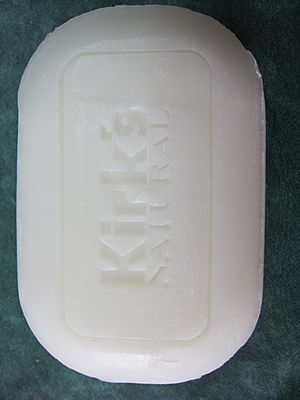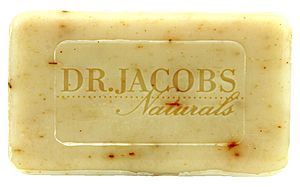Castile soap facts for kids
Castile soap is a special type of hard soap. It is mostly made from olive oil. This soap gets its name because it was first made in the Castile region of Spain.
Contents
The Story of Castile Soap
Ancient Beginnings
The idea for Castile soap started a very long time ago. It began in a region called the Levant. This area includes parts of the Middle East. Soap makers there created hard soaps. They used olive oil and also laurel oil. People have been making these soaps for thousands of years.
How Soap Came to Europe
Many people think that Crusaders brought soap to Europe. This happened around the 11th century. However, the ancient Greeks knew about soap much earlier. They used it in the first century AD. A person named Zosimos of Panopolis wrote about soap making around 300 AD. After the Crusades, soap making spread. It became popular all around the Mediterranean Sea.
Why Castile Soap is Different
Early soap makers in the Mediterranean could not easily get laurel oil. So, they stopped using it in their soap. They focused on using only olive oil. This is how the olive-oil soap we now call Castile soap was born.
Castile soap is named after the Crown of Castile. This was a powerful kingdom in Spain. They made a lot of this soap. Then, they sold it to many places in Europe. This happened mostly during the Modern Age. While other places made similar soaps, Castile was the most famous producer.
A Soap Controversy in England
In the 1600s, Castile soap caused a big stir in England. The Spanish Catholic makers bought a special right. This right was a monopoly from King Charles I. A monopoly meant they were the only ones allowed to sell this type of soap. This made local English soap makers upset.
Because the company was Catholic, some people in Protestant England were against it. There was a campaign to show that local soaps were better. Washerwomen even demonstrated this. Selling a monopoly to a Catholic company caused a huge public outcry. In the end, the Castile soap company lost its special monopoly.
How Castile Soap Was Made
"Castile soap" started appearing in London in the late 1500s. It was imported through a city called Antwerp. Historians believe that early Castile soap was made by boiling olive oil. They added a substance called barilla. This was an impure form of sodium carbonate. It came from the ashes of certain salty plants.
After boiling, they added salty water. This made the soap float to the top. The soap maker could then skim it off. This left behind extra lye and impurities. Aleppo soap is usually green. But this method made the first white hard soap. It got even harder and whiter as it aged. This was known as jabón de Castilla.
Apothecaries, who were like early pharmacists, knew this soap. They called it sapo hispaniensis (Spanish soap) or sapo castilliensis (Castilian soap) in Latin.
Today, some companies call their soap "Castile soap" even if it has little or no olive oil. This is different from the original, real olive oil soap.
See also
 In Spanish: Jabón de Castilla para niños
In Spanish: Jabón de Castilla para niños




